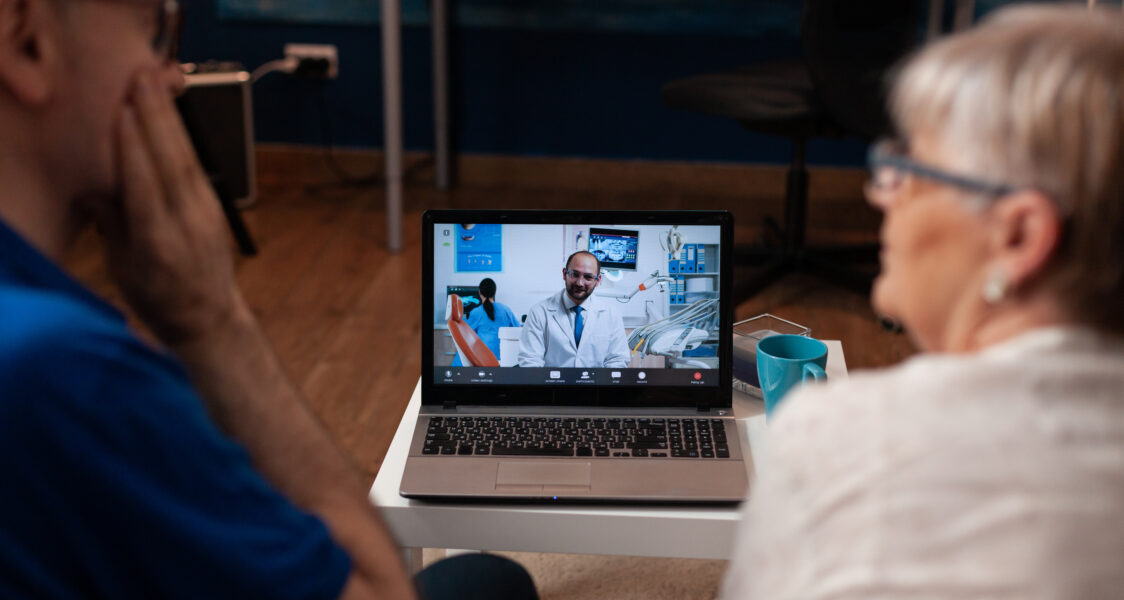Exploring the Use of Telemedicine in Senior Care
Telemedicine is revolutionizing healthcare for older adults, providing convenient, cost-effective solutions for managing chronic conditions and accessing specialized care. Explore its impact, challenges, and practical tips to make the most of this growing resource.

Telemedicine is redefining healthcare delivery for older adults by bridging gaps in accessibility, convenience, and personalized medical care. By integrating digital tools like video consultations, remote monitoring, and patient data platforms, telemedicine provides seniors with medical services that meet their unique needs. The COVID-19 pandemic highlighted its importance of telehealth services in enabling continuity of care when in-person visits were not feasible.
In this article from Koelsch Communities, we’ll examine the benefits, challenges, and future of telemedicine in senior care while offering insights for families considering its role in supporting their loved ones. Let’s get started!
What Is Telemedicine and How Does It Support Seniors?
Defining Telemedicine
Telemedicine refers to the use of telehealth technologies to deliver medical care remotely. These include video calls, mobile apps, patient portals, and remote health monitoring devices. For seniors, this means they can access medical advice, manage chronic conditions, and receive mental health support without needing to visit a doctor’s office or hospital.
Beyond convenience, telemedicine has expanded healthcare’s reach, enabling providers to monitor patients’ conditions in real time and respond promptly to changes. The immediate feedback telemedicine offers can prevent complications and improve health outcomes.
Meeting Seniors’ Healthcare Needs
Older adults are more likely to experience chronic illnesses, mobility challenges, and transportation limitations that make in-person visits difficult. Telehealth technologies address these obstacles by allowing seniors to consult with providers from their homes. Additionally, it reduces long wait times and facilitates quicker access to specialists, improving overall quality of care.
For example, telemedicine has become a vital tool for managing conditions such as diabetes, high blood pressure, and arthritis. Regular virtual check-ins help older adults and their healthcare providers adjust diagnosis and treatment plans based on current symptoms so they can keep these conditions under control.
Benefits of Telemedicine in Senior Care
Increased Access to Healthcare
One of telemedicine’s most significant advantages is its ability to improve access for seniors who face geographic or physical barriers. For those in rural areas, where specialists may be hours away, telemedicine makes healthcare more attainable. Similarly, for seniors with reduced mobility, video consultations eliminate the need for travel and enable them to receive timely medical attention.
Cost-Effective Solutions
Telemedicine reduces costs for families and communities. Families save on transportation expenses and missed workdays, while communities see lower healthcare expenditures due to reduced emergency room visits and hospital readmissions. For seniors on fixed incomes, this cost-effectiveness makes it easier to prioritize regular medical care.
Chronic Disease Management
Telemedicine allows seniors to manage chronic illnesses effectively through continuous monitoring. Devices that measure blood pressure, glucose levels, or oxygen saturation send data directly to healthcare providers, who can adjust treatment plans accordingly. This proactive approach minimizes the risk of complications and improves long-term health outcomes.
Convenience for Caregivers
For caregivers, telemedicine offers a practical way to stay involved in their loved ones’ healthcare. Virtual appointments provide opportunities for caregivers to ask questions, provide context about symptoms, and collaborate with healthcare providers, all without disrupting their daily routines.
Current Applications of Telemedicine in Senior Care
Routine Medical Consultations
Routine check-ups and follow-up appointments are among the most common uses of telemedicine. These virtual visits ensure continuity of care by allowing seniors to address minor health concerns, manage medications, and discuss new symptoms with their primary care providers.
Mental Health Services
Older adults face unique mental health challenges, including anxiety, depression, and loneliness. Teletherapy offers a private and convenient way to access counseling and therapy services, which can significantly improve emotional well-being. Telemedicine has also reduced the stigma surrounding mental health care by making it more accessible to seniors.
Post-Hospitalization Care
Telemedicine is especially useful for seniors recovering from hospital stays. Virtual follow-ups help monitor recovery, manage medications, and address concerns before they escalate into complications. This reduces the likelihood of readmissions, a common issue among older patients.
Specialized Medical Services
Telemedicine enables seniors to access specialists in areas like cardiology, endocrinology, and dermatology. These services are particularly valuable for conditions requiring ongoing management or advanced expertise, which may not be readily available in local communities.
Challenges in Telemedicine for Older Adults
Technological Barriers
Older adults often face difficulties with technology, including limited digital literacy or access to necessary devices like smartphones, tablets, or computers. Providing seniors with training on telemedicine platforms, as well as designing user-friendly interfaces, can help overcome these challenges.
Limited Internet Access
Internet connectivity remains a significant barrier, particularly in rural areas. Expanding broadband infrastructure is essential for improved access to telehealth services and ensuring that all seniors, regardless of location, can benefit from telemedicine services.
Building Trust in Virtual Care
For some seniors, virtual care can feel impersonal or intimidating. Healthcare providers must prioritize building trust through clear communication, empathy, and patient-centered approaches. Ensuring seniors understand the process and benefits of telemedicine can also alleviate hesitations.
Ethical and Legal Considerations in Telemedicine
Protecting Patient Data
Data security is a critical concern in telemedicine. Healthcare providers must use HIPAA-compliant platforms to safeguard sensitive patient information. Families should verify that telemedicine services prioritize security and transparency to protect their loved ones’ privacy.
Navigating Licensing Challenges
Telemedicine often involves cross-state consultations, especially when specialized care is required. Providers must comply with varying state regulations and licensing requirements, which can limit access for seniors seeking care from experts outside of state lines.
Limitations of Telemedicine in Senior Care
Lack of Physical Examinations
Certain conditions require hands-on assessments that telemedicine cannot provide. While telemedicine can address many routine and chronic issues, it should complement in-person care to ensure comprehensive evaluations when physical examinations are necessary.
Reduced Social Interaction
For seniors, personal connections with healthcare providers often offer reassurance and emotional support. Telemedicine visits can feel less engaging than face-to-face visits, making it important to balance virtual and in-person interactions.
Telemedicine’s Role in Preventive Care
Early Detection of Health Issues
Regular telemedicine appointments help primary care providers monitor seniors for early signs of health problems. Identifying issues like fluctuating blood pressure or irregular heart rates can prompt timely interventions that prevent further complications.
Promoting Healthy Lifestyles
Telemedicine platforms often include educational resources on nutrition, exercise, and stress management. These tools empower seniors to adopt healthier habits, reducing the risk of chronic diseases and improving overall well-being.
Future Trends in Telemedicine
Advancements in Wearable Technology
Wearable devices equipped with sensors provide real-time health data, such as heart rate, oxygen levels, and physical activity. These devices are becoming increasingly sophisticated, allowing healthcare providers to detect changes in health conditions early.
Expanding Access in Underserved Areas
Efforts to improve broadband access in rural and underserved regions aim to make telemedicine available to all seniors. These initiatives are essential for bridging the digital divide and ensuring equitable healthcare access.
Practical Tips for Seniors Using Telemedicine
Selecting a Suitable Platform
When choosing a telemedicine platform, families should prioritize ease of use, reliability, and security. Look for platforms with simple navigation, accessible customer support, and secure data handling to ensure a seamless experience.
Preparing for Virtual Appointments
To make the most of telemedicine your next telemedicine visit:
- Test your internet connection and device before the appointment.
- Write down questions or concerns in advance.
- Choose a quiet, well-lit space to minimize distractions during the consultation.
Closing Thoughts
Telemedicine has become an essential tool in senior care, improving access, convenience, and support for older adults and their families. While it cannot replace all aspects of in-person care, its benefits outweigh many of the challenges. As technology continues to evolve, telemedicine’s role in preventive care, chronic disease management, and mental health support will expand and offer even greater value to seniors.
About Koelsch Communities
Koelsch Communities offers a wide range of “Mom-approved” senior living options designed to create fulfilling and enjoyable experiences. With over 60 years of experience, we have built a reputation for providing top-quality care and exceptional senior living environments. Our communities are staffed by professionals dedicated to treating our Ladies and Gentlemen with respect and providing the special attention they need.
We pride ourselves on our high customer satisfaction, which reflects our commitment to excellence. Our experienced team ensures that every resident feels valued and cared for, promoting a thriving and supportive community atmosphere.
For more information about our senior living options and to discover how we can help you or your loved one enjoy the finest living experiences, please contact us today. We look forward to welcoming you to our community and helping you find the perfect senior living solution.
Disclaimer: This article is for informational purposes only and does not constitute medical, legal, or financial advice. It’s recommended to consult with a medical, legal, or financial professional for your specific circumstances.









